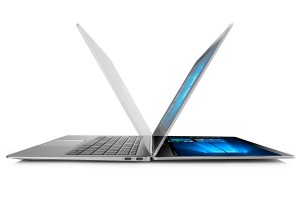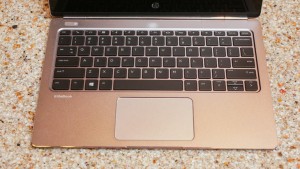

Within the in depth review Ars Technica did comparing the MacBook with the Elitebook Folio G1, its original first impression was that the Elitebook looked like “a MacBook with two ports”. That suggests we’ve got a long list of comparisons to take a gander at. Starting with design, the Folio G1, also made with a matte silver aluminum chassis and glass screen, is a 2.14 pound laptop, measuring 11.5 inches x 8.23 inches; making it both a little heavier and larger than Apple’s device. Unlike the MacBook, the Folio G1 has a 180 degree hinge. Also good to note, it can take a beating, as HP gave it MIL-STD 810G durability for dust, vibration, shocks, high altitudes, and you can also drop it a good 30 inches, 26 times, at different angles, and nothing will happen (Thanks Laptop Mag, for trying that one out for us).


Onto performance, because it’s important when comparing to an Apple device, the Folio G1 uses Intel Core M, as many new thin laptops do. This device starts out at a 1.1GHz Intel Core M5-6Y57 Skylake processor, topping out at 2.8GHz Turbo (other units reach a good 3.1GHz with Intel’s Core M7), and an Intel HD 515 GPU. Whatever configuration you choose, the laptop comes with 8GB RAM, an optional 128GB to 256GB NVMe SSD, Wi-Fi, Bluetooth 4.2, plus two USB Type-C ports.
So it sports Core M, nothing special in the department of battery life and performance right? As far as many of the thin notebooks and 2-in-1s sporting Core M, mixed reviews are all around. For the most part, I bet we can expect good things from Folio G1’s performance, because hey, it starts out at the newer gen M5 chips. Also, both Laptop Mag and Ars Technica reported high benchmark scores when handling multitudes of task windows open. Battery life, with the base display, will last a good 7 hours; 4K however, you “won’t want to stray too far from an outlet”, says Laptop Mag. The Folio G1 has more ports than the MacBook, and hails in first-class design. Starting at $999, the Elitebook Folio G1, size and productivity wise, is within a great range for getting lots of work done. Take that, and add display quality, superior typing customization, and, um, a bit of a disconnect in battery life, you can decide to weigh your pros and cons in your own manner. But since that’s basically the only compromise you’ll have to make, I’d say go for it.

 Laptop & Tablet Parts
Laptop & Tablet Parts




















